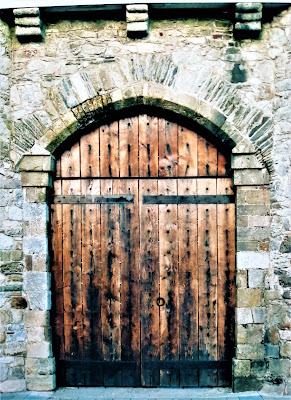Spur-Stones
These stones were once very common in Irish towns and villages. They are usually circular in shape (like a bollard) but sometimes they can be square in shape. They are usually fixed in the road against the angle of a building or on either side of an archway and protected the base of corners from the wheels of carts rubbing against the corners.
 |
| Spur-stone at The Anchor |
 |
| Spur-stone at the Lookout |
Stone Doorcases
There is a fine entrance doorcase in limestone at Friary
House in Main Street. The building
designed by George Ashlin was started in 1871 and completed in 1873. It is contrasted with the surrounding red
bricks. The principal windows of the
building are also in limestone.
One of the oldest surviving doorways (of sandstone) in
Dungarvan can be seen in Barrack Lane on the building known as ‘St Garvan’s
Church’. The building is now believed to
be a merchant’s house, and dates to the 16th century. Across the street some of the oldest stonework
in the town can be seen in Dungarvan Castle. It includes some fragments of Dundry stone
from Bristol in the keep, which was normally reserved for decoration around
windows and doors. More early stonework
can be seen in the ruins of the Augustinian Abbey in Abbeyside.
 |
| St. Garvan Church Doorway |
 |
| Castle Gateway |
 |
| Friary House Doorway |
Sea walls
There are some fine examples of limestone walls around the town at the Youghal Road, Shandon, Quanns, and Duckspool. These were constructed in the 19th century and are so well-built that they have survived to the present day without major repairs. It is believed that these walls were built as part of relief work during the Great Famine.
 |
| Wall at Shandon, 1859 |